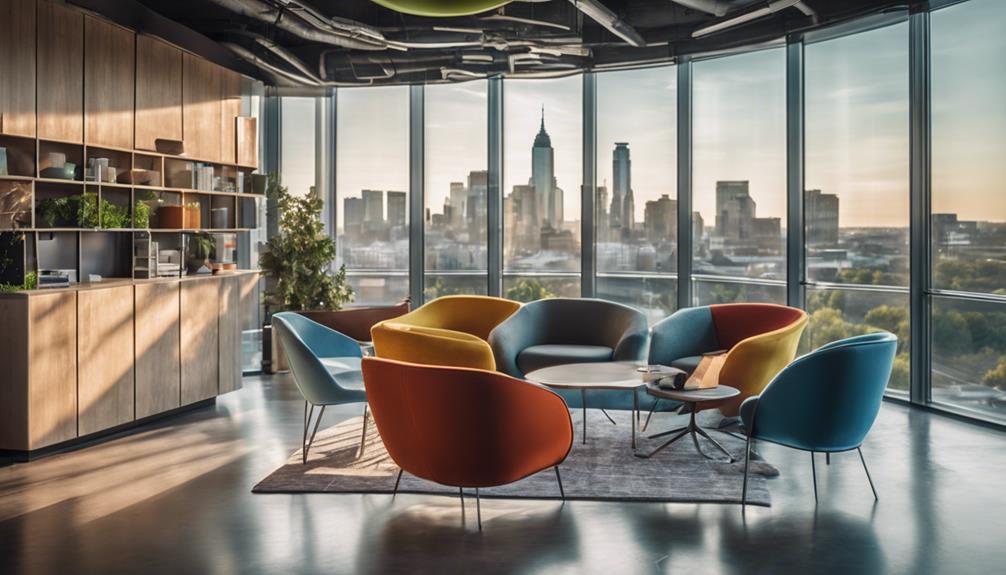You're stepping into a future where office spaces embrace flexibility, technology, and wellness. Say goodbye to traditional cubicles and hello to open layouts that promote collaboration. Spec suites are gaining popularity, allowing quick adjustments based on tenant needs. With smart desks and virtual meeting rooms, tech becomes an integral part of your workspace. As remote work redefines office strategies, designs focus on enhancing employee well-being and boosting productivity. This evolution opens doors to innovative models like Furniture-as-a-Service. If you're curious about how these trends will shape your work environment, there's plenty more to uncover ahead.
Key Takeaways
- Office spaces are evolving to prioritize wellness and collaboration, moving away from traditional cubicles to open layouts and communal areas.
- The rise of spec suites provides tailored, move-in ready workspaces, reducing setup times and enhancing productivity from day one.
- Financially, landlords face upfront investments for spec suites, emphasizing the need for accurate cost assessments to maintain profitability.
- Future trends include the growth of Furniture-as-a-Service models, offering flexible furniture solutions to adapt to changing tenant needs.
Evolution of Office Spaces
Over the years, office spaces have transformed significantly to meet the changing demands of the workforce and advancements in technology.
You've likely noticed how traditional cubicles are being replaced by open layouts, collaborative areas, and wellness-focused designs. These changes aim to foster creativity and enhance employee well-being.
As remote work becomes more prevalent, companies are rethinking their office strategies, focusing on flexibility and adaptability. You might find yourself in environments that prioritize technology integration, offering features like smart desks and virtual meeting rooms.
This evolution isn't just about aesthetics; it's about creating spaces that nurture productivity and collaboration.
The Rise of Spec Suites
As companies seek greater flexibility in their office environments, the demand for spec suites has surged, offering tailored solutions that cater to evolving workspace needs.
These furnished, speculative spaces provide a quick and adaptable option for businesses looking to move in without the hassle of extensive renovations. By allowing you to customize your environment, spec suites address the changing demands of modern workforces, especially post-pandemic.
They also help landlords attract potential tenants by presenting ready-to-use spaces that eliminate lengthy setup times. With spec suites, you can enjoy a seamless transition into your office, ensuring that both you and your team can focus on productivity and collaboration from day one.
Flexibility has never been more accessible.
Financial Implications for Landlords

Understanding the financial implications of investing in spec suites is crucial for landlords looking to optimize their returns while meeting tenant demands. An upfront investment typically ranges from $15 to $20 per square foot, plus additional costs for design and installation.
You'll also need to account for potential hidden expenses, such as labor adjustments and offsite storage for excess inventory. Financial planning plays a vital role in mitigating these risks. By accurately assessing these costs, you can ensure that your investment remains profitable.
Moreover, you can attract tenants more effectively, creating a competitive edge in a rapidly evolving market. Balancing these financial factors will ultimately help you achieve long-term success in managing your properties.
Overcoming Implementation Challenges
Implementing spec suites can pose several challenges that require proactive strategies to ensure success.
First, you should clearly understand tenant needs to avoid mismatches with your designs. Regular communication with potential tenants can help you adapt your offerings effectively.
If labor adjustments are necessary, re-engaging skilled workers promptly will minimize disruptions. Additionally, streamline inventory management to prevent inefficiencies caused by moving unneeded furniture.
Focus on creating spaces that are genuinely ready for occupancy rather than staging.
Lastly, be mindful of lead times; consider strategies to expedite logistics and enhance the move-in experience.
Future Trends in Flexible Workspaces

With the growing demand for flexibility in work environments, the future of office spaces is set to embrace innovative designs that cater to diverse tenant needs. These changes will likely include multifunctional areas, modular furniture, and technology-driven solutions that foster collaboration and productivity. By prioritizing adaptability, businesses can better accommodate hybrid models and evolving workforce preferences. The shift highlights how flexible office spaces benefits both employers and employees, offering a blend of efficiency, creativity, and work-life balance.
You'll see a rise in spec suites, allowing quick adaptations to various requirements. Furniture-as-a-Service (FaaS) models will become popular, letting you access furniture without hefty upfront costs. These trends will streamline operations and enhance tenant satisfaction by offering options for location, term, and style.
You'll also notice spaces designed for collaboration, promoting teamwork and creativity. As remote work continues, hybrid models will flourish, blending traditional and flexible setups.
Conclusion
As you navigate the future of office spaces, consider this: studies show that companies with flexible work environments see a 20% increase in employee satisfaction.
Embracing spec suites not only meets the demand for adaptability but also enhances productivity and morale.
By staying ahead of trends and understanding the financial and practical implications, you're positioning yourself for success in this dynamic landscape.
The future of work is here, and it's time to make the most of it.










